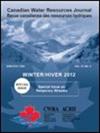利用不同来源和时间分辨率的数据对受季节性冰盖影响的河流的热状况进行建模
IF 1.7
4区 环境科学与生态学
Q3 WATER RESOURCES
引用次数: 2
摘要
为了全面了解河流热状态的时空格局,需要在连续的长时间序列和不同的环境中记录温度。不幸的是,这些数据在广泛的地区通常是稀缺的。在加拿大,利用标准化的三参数高斯函数和在158条曲海流域收集的连续温度记录,首次尝试对河流热状态进行一般的大规模表征。该模型提供了河流年最高温度、年最高温度发生日期和暖季持续时间的估计,其置信区间与可用时间序列的持续时间有关。然而,由此产生的热图在空间上受到监测站地理位置的限制,监测站仅限于该省东部。它还基于相对较短和最近的温度序列,大多数记录都不到五年,而且是从2010年以后开始的。在这项工作中,我们通过增加新的温度数据源,即卫星热数据和现场测量,扩大了曲海热图的空间和时间跨度。从1980年代初到今天,卫星数据提供了难以获得现场数据的偏远北部地区的热信息。从Banque de donnsames sur la qualit本文章由计算机程序翻译,如有差异,请以英文原文为准。
Modeling of the thermal regime of rivers subject to seasonal ice cover using data from different sources and temporal resolutions
Abstract A comprehensive picture of the spatial and temporal patterns of river thermal regimes requires temperature recorded over continuous long time series and across various environments. Unfortunately, these data are generally scarce in extended areas. In Canada, the first attempt to a general large-scale characterization of river thermal regimes was done using a standardized three-parameter Gaussian function and continuous temperature records collected in 158 Québec rivers. This model provided estimates of the river temperature annual maximum, the date of the annual maximum occurrence and the duration of the warm season, with confidence intervals linked to the duration of the available time series. This resulting thermal map was however limited spatially by the geographical location of the monitoring stations, restricted to the eastern portion of the province. It was also based on relatively short and recent temperature series, with most records shorter than five years and starting after 2010. In this work, we expanded both the space and time spans of the Québec rivers thermal map by adding new temperature data sources, namely satellite thermal data and spot measurements. Satellite data provided thermal information in remote northern regions where in situ data acquisition is difficult, from early 1980s until today. Spot measurements from the Banque de données sur la qualité des milieux aquatiques allowed to add nearly 250 rivers to the Québec thermal regimes characterization, with several stations operating since 1979. These three data sources were combined to characterize Québec rivers thermal regimes in more than 400 rivers and streams, over an extended geographical distribution. Uncertainty brought by the coarser temporal resolution of the spot and combined time series was assessed and found to result in substantially larger confidence intervals on the estimated model parameters, as compared with the confidence intervals obtained when using continuous time series of similar length.
求助全文
通过发布文献求助,成功后即可免费获取论文全文。
去求助
来源期刊

Canadian Water Resources Journal
WATER RESOURCES-
CiteScore
2.90
自引率
5.90%
发文量
17
审稿时长
>12 weeks
期刊介绍:
The Canadian Water Resources Journal accepts manuscripts in English or French and publishes abstracts in both official languages. Preference is given to manuscripts focusing on science and policy aspects of Canadian water management. Specifically, manuscripts should stimulate public awareness and understanding of Canada''s water resources, encourage recognition of the high priority of water as a resource, and provide new or increased knowledge on some aspect of Canada''s water.
The Canadian Water Resources Journal was first published in the fall of 1976 and it has grown in stature to be recognized as a quality and important publication in the water resources field.
 求助内容:
求助内容: 应助结果提醒方式:
应助结果提醒方式:


